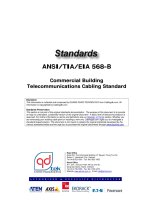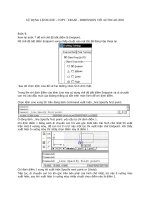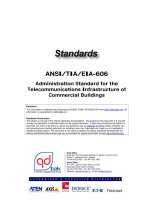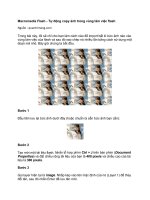Telecommunications demystified copy
Bạn đang xem bản rút gọn của tài liệu. Xem và tải ngay bản đầy đủ của tài liệu tại đây (2.96 MB, 376 trang )
Telecommunications
Demystified
A Streamlined Course in Digital Communications
(and some Analog) for EE Students and
Practicing Engineers
by Carl Nassar
Eagle Rock, Virginia
www.LLH-Publishing.com
www.elsolucionario.net
Librar y of Congress Cataloging-in-Publication Data
Nassar, Carl, 1968
Telecommunications demystified / by Carl Nassar.
p. c.m. -- (Demystifying technology series)
Includes bibliographical references and index.
ISBN 1-878707-55-8 (alk. paper)
1. Telecommunication. I. Title. II. Series.
TK5101 .N257 2000
621.382--dc21
00-062902
Copyright © 2001 by LLH Technology Publishing.
All rights reser ved. No part of this book may be reproduced, in any form or means
whatsoever, without written permission from the publisher. While ever y precaution
has been taken in the preparation of this book, the publisher and author assume no
responsibility for errors or omissions. Neither is any liability assumed for damages
resulting from the use of the information contained herein.
Printed in the United States of America
10 9 8 7 6 5 4 3 2 1
Cover design: Jim Johnson
Developmental editing: Carol Lewis
Production: Kelly Johnson
Visit us on the web: www.LLH-Publishing.com
For revisions and updates, check www.telecommunicationsdemystified.com
www.elsolucionario.net
www.elsolucionario.net
1 Introducing Telecommunications ............................................
1
Communication Systems ..............................................................................
1
Definition .............................................................................................................
The Parts of a Communication System ..............................................................
An Example of a Communication System ..........................................................
The Transmitter ..................................................................................................
The Channel .......................................................................................................
The Receiver ......................................................................................................
1
2
2
3
3
3
Telecommunication Systems ........................................................................
3
Definition .............................................................................................................
Four Examples and an Erratic History Lesson ...................................................
3
4
Analog and Digital Communication Systems ................................................
6
Some Introductory Definitions .............................................................................
Definitions ...........................................................................................................
And Digital Became the Favorite ........................................................................
Making It Digital ..................................................................................................
6
7
8
9
Congrats and Conclusion .............................................................................
Problems.......................................................................................................
10
11
2 Telecommunication Networks..................................................
2
Telecommunication Network Basics .............................................................
2
Connecting People with Telephones ..................................................................
Connecting More People, Farther Apart .............................................................
Multiplexing�An Alternative to a Lot of Wire ........................................................
First There Was FDM .........................................................................................
Along Came TDM ...............................................................................................
2
14
16
16
18
POTS: Plain Old Telephone System ............................................................
19
Local Calls ..........................................................................................................
Long Distance Calls ............................................................................................
Connecting the Call ............................................................................................
The Signals Sent from Switching Center to Switching Center ............................
Class 5 to Class 4 ...............................................................................................
Other Signals between Switching Centers .........................................................
19
20
20
21
22
24
Communication Channels.............................................................................
24
Transmission Lines (Wires) ................................................................................
Terrestrial Microwave .........................................................................................
Satellite Connections ..........................................................................................
Fiber-optic Links .................................................................................................
24
26
28
29
Data Communication Networks ....................................................................
Mobile Communications ...............................................................................
Local Area Networks (LANs) ........................................................................
Conclusion ....................................................................................................
Problems.......................................................................................................
31
33
35
37
38
3 A Review of Some Important Math, Stats, and Systems .......
3
Random Variables ........................................................................................
3
Definitions ...........................................................................................................
The Distribution Function: One Way to Describe x .............................................
The Density Function: A Second Way to Describe x ..........................................
The Mean and the Variance ...............................................................................
Example 3.1 ........................................................................................................
Multiple Random Variables .................................................................................
3
3
40
41
43
44
Random Processes ......................................................................................
45
www.elsolucionario.net
A Definition .........................................................................................................
Expressing Yourself, or a Complete Statistical Description ................................
Expressing Some of Yourself, or a Partial Description .......................................
And in Telecommunications � ..............................................................................
Example 3.2 ........................................................................................................
45
47
47
48
48
Signals and Systems: A Quick Peek ............................................................
50
A Few Signals .....................................................................................................
Another Way to Represent a Signal: The Fourier Transform .............................
Example 3.3 ........................................................................................................
Bandwidth ...........................................................................................................
A Linear Time Invariant (LTI) System .................................................................
Some Special Linear Time Invariant (LTI) Systems ...........................................
50
51
52
53
55
56
Onward .........................................................................................................
Problems.......................................................................................................
58
x
4 Source Coding and Decoding: .................................................
4
Sampling .......................................................................................................
4
Ideal Sampling ....................................................................................................
The Sampling......................................................................................................
The Information in the Samples ..........................................................................
Getting Back All the Information from the Samples ............................................
Some Commonly Used Words ...........................................................................
Example 4.1 ........................................................................................................
Zero-order Hold Sampling ..................................................................................
The Information in the Samples ..........................................................................
Example 4.2 ........................................................................................................
Natural Sampling ................................................................................................
The Information in the Samples ..........................................................................
4
4
62
64
65
66
67
67
68
69
70
Quantization..................................................................................................
71
Meet the Quantizer .............................................................................................
Example 4.3 ........................................................................................................
Who wants it? .....................................................................................................
Quantizer Terms .................................................................................................
Types of Quantizers............................................................................................
Example 4.4 ........................................................................................................
The Good Quantizer ...........................................................................................
What Is a Good Quantizer? ................................................................................
Measures of Performance ..................................................................................
A �Classic� ...........................................................................................................
Creating the Good Quantizer ..............................................................................
Example 4.5 ........................................................................................................
The Quantizer and the Telephone ......................................................................
The Idea..............................................................................................................
71
73
73
74
75
76
77
77
77
78
81
86
88
88
Source Coding: Pulse Code Modulator (PCM) .............................................
92
Introducing the PCM ...........................................................................................
PCM Talk ............................................................................................................
The �Good� PCM .................................................................................................
Source Decoder: PCM Decoder .........................................................................
92
93
94
95
Predictive Coding..........................................................................................
96
The Idea Behind Predictive Coding ....................................................................
Why? ...................................................................................................................
The Predicted Value and the Predictive Decoder ...............................................
The Delta Modulator (DM) ..................................................................................
How the DM creates an ......................................................................................
The Block Diagram of the DM .............................................................................
The Sampler and the Quantizer in the DM .........................................................
97
97
98
99
99
100
100
www.elsolucionario.net
The Signals in the DM ........................................................................................
Example 4.6 ........................................................................................................
Overload and Granular Noise .............................................................................
Differential PCM (DPCM)....................................................................................
The Predicted Value ...........................................................................................
Example 4.7 ........................................................................................................
The Block Diagram .............................................................................................
2
104
105
107
107
109
109
Congrats and Conclusion .............................................................................
Problems.......................................................................................................
110
111
5 Getting It from Here to There: ..................................................
5.1
An Introduction..............................................................................................
Modulators ....................................................................................................
5.1
116
Baseband Modulators .........................................................................................
NRZ Modulators..................................................................................................
RZ Modulators ....................................................................................................
Phase-encoded Modulators ................................................................................
Which Modulator to Use? ...................................................................................
Example 5.1 ........................................................................................................
Bandpass Modulators .........................................................................................
ASK .....................................................................................................................
PSK .....................................................................................................................
FSK .....................................................................................................................
QAM....................................................................................................................
Example 5.2 ........................................................................................................
Choosing a Modulation Method ..........................................................................
116
117
118
120
122
124
124
125
127
129
130
131
131
Just-in- Time Math, or How to Make a Modulator Signal Look Funny ..........
133
The Idea..............................................................................................................
Example 5.3 ........................................................................................................
Representing Modulated Signals ........................................................................
BPSK ..................................................................................................................
PSK .....................................................................................................................
ASK .....................................................................................................................
QAM....................................................................................................................
134
136
138
139
140
143
145
Bring it Home, Baby, or Demodulators .........................................................
146
What Demodulators Do ......................................................................................
The Channel and Its Noise .................................................................................
Building a Demodulator, Part I�the Receiver Front End ......................................
What it does ........................................................................................................
An orthonormal basis for r(t) ...............................................................................
Representing r(t) as a vector using the orthonormal basis .................................
Building the Receiver Front End .........................................................................
Example 5.4 ........................................................................................................
The Rest of the Demodulator, Part II�The Decision Makers ...............................
What It Does .......................................................................................................
How It Works ......................................................................................................
How to Build It .....................................................................................................
The Correlator Receiver .....................................................................................
Example 5.5 ........................................................................................................
The Matched Filter Receiver�Version 1 ..............................................................
The Matched Filter Receiver �Version 2 .............................................................
146
147
148
148
148
149
151
152
152
152
153
156
156
157
158
159
How Good Is It Anyway (Performance Measures)........................................
161
A Performance Measure .....................................................................................
Evaluation of .......................................................................................................
for Simple Cases ................................................................................................
The BPSK Modulator Remembered ...................................................................
161
162
162
162
www.elsolucionario.net
The BPSK Demodulator: A Summary .................................................................
Evaluating the P( ................................................................................................
Some Well-known P( ..........................................................................................
s ..........................................................................................................................
162
163
166
166
What We Just Did .........................................................................................
Problems.......................................................................................................
166
167
6 Channel Coding and Decoding: ...............................................
0
Simple Block Coding.....................................................................................
172
The Single Parity Check Bit Coder .....................................................................
Example 6.1 ........................................................................................................
Some Terminology..............................................................................................
Rectangular Codes .............................................................................................
Channel Coders for Rectangular Codes .............................................................
Channel Decoders for Rectangular Codes .........................................................
Example 6.2 ........................................................................................................
172
174
175
175
175
176
176
Linear block codes ........................................................................................
177
Introduction .........................................................................................................
Example 6.3 ........................................................................................................
Understanding Why ............................................................................................
Systematic Linear Block Codes ..........................................................................
Example 6.4 ........................................................................................................
The Decoding .....................................................................................................
Example 6.5 ........................................................................................................
Example 6.6 ........................................................................................................
177
178
179
181
181
182
184
186
Performance of the Block Coders .................................................................
188
Performances of Single Parity Check Bit Coders/Decoders ...............................
The Performance of Rectangular Codes ............................................................
The Performance of Linear Block Codes ............................................................
Example 6.7 ........................................................................................................
188
189
189
190
Benefits and Costs of Block Coders .............................................................
Conclusion ....................................................................................................
Problems.......................................................................................................
192
193
194
7 Channel Coding and Decoding: ...............................................
1
Convolutional Coders ...................................................................................
1
Our Example .......................................................................................................
Making Sure We�
...................................................................................
ve Got It
Polynomial Representation .................................................................................
The Trellis Diagram ............................................................................................
Example 7.1 ........................................................................................................
1
199
200
201
202
Channel Decoding ........................................................................................
203
Using a Trellis Diagram ......................................................................................
Example 7.2 ........................................................................................................
The Viterbi Algorithm ..........................................................................................
Example 7.3 ........................................................................................................
204
206
206
212
Performance of the Convolutional Coder......................................................
Catastrophic Codes ......................................................................................
Building Your Own ........................................................................................
Problems.......................................................................................................
213
214
216
217
8 Trellis-Coded Modulation (TCM) ..............................................
8
The Idea........................................................................................................
Improving on the Idea ...................................................................................
222
225
www.elsolucionario.net
Example 8.1 ........................................................................................................
229
The Receiver End of Things .........................................................................
230
The Input .............................................................................................................
The TCM Decoder Front End .............................................................................
The Rest of the TCM Decoder ............................................................................
Example 8.2 ........................................................................................................
Searching for the Best Path ................................................................................
231
233
234
236
237
Problems.......................................................................................................
242
9 Channel Filtering and Equalizers.............................................
i
Modulators and Pulse Shaping .....................................................................
i
Example 9.1 ........................................................................................................
248
The Channel That Thought It Was a Filter ....................................................
249
Example 9.2 ........................................................................................................
250
Receivers: A First Try ...................................................................................
251
The Proposed Receiver ......................................................................................
Making the Receiver a Good One ......................................................................
The Proposed Receiver: Problems and Usefulness ...........................................
Example 9.3 ........................................................................................................
251
254
256
257
Optimal Receiver Front End .........................................................................
Optimal Rest-of-the-Receiver .......................................................................
258
262
The Input .............................................................................................................
A Problem with the Input, and a Solution............................................................
The Final Part of the Optimal Receiver ...............................................................
Example 9.4 ........................................................................................................
An Issue with Using the Whitening Filter and MLSE ..........................................
262
264
265
270
271
Linear Equalizers ..........................................................................................
271
Zero Forcing Linear Equalizer ............................................................................
MMSE (Minimum Mean Squared Error) Equalizer .............................................
Example 9.5 ........................................................................................................
272
273
273
Other Equalizers: the FSE and the DFE .......................................................
Conclusion ....................................................................................................
Problems.......................................................................................................
274
275
276
10 Estimation and Synchronization ............................................
10
Introduction ...................................................................................................
Estimation: Part 1 .........................................................................................
10
280
Our Goal .............................................................................................................
What We Need to Get an Estimate of a Given r .................................................
Estimating a Given r, the First Way ....................................................................
Estimating a Given r, the Second Way ...............................................................
Estimating a Given r, the Third Way ...................................................................
Example 10.1 ......................................................................................................
280
281
281
282
283
283
Evaluating Channel Phase: A Practical Example .........................................
285
Our Example and Its Theoretically Computed Estimate .....................................
The Practical Estimator: the PLL ........................................................................
Updates to the Practical Estimator in MPSK ......................................................
285
290
292
Conclusion ....................................................................................................
Problems.......................................................................................................
295
296
11 Multiple Access Schemes.......................................................
11
What It Is.......................................................................................................
The Underlying Ideas....................................................................................
11
300
Example 11.1 ......................................................................................................
302
www.elsolucionario.net
TDMA............................................................................................................
303
Example 11.2 ......................................................................................................
305
FDMA............................................................................................................
CDMA ...........................................................................................................
305
306
Introduction .........................................................................................................
DS-CDMA ...........................................................................................................
FH-CDMA ...........................................................................................................
MC-CDMA ..........................................................................................................
306
310
312
313
CIMA.............................................................................................................
Conclusion ....................................................................................................
Problems.......................................................................................................
315
318
319
12 Analog Communications ........................................................
12.1
Modulation�An Overview ...............................................................................
Amplitude Modulation (AM) ..........................................................................
12.1
322
AM Modulators�in Time .......................................................................................
Example 12.1 ......................................................................................................
AM Modulation�in Frequency ..............................................................................
Demodulation of AM Signals�Noise-Free Case ..................................................
An Alternative to AM�DSB-SC ............................................................................
Example 12.2 ......................................................................................................
323
325
326
328
330
333
Frequency Modulation (FM) ..........................................................................
334
The Modulator in FM ...........................................................................................
Example 12.3 ......................................................................................................
The Demodulator in FM ......................................................................................
335
338
339
The Superheterodyne Receiver ....................................................................
Summary ......................................................................................................
Problems.......................................................................................................
339
341
342
Annotated References and Bibliography ...................................
5.
Index ..............................................................................................
175
www.elsolucionario.net
Acknowledgments
In this life of mine, I have been blessed with an abundance of wonderful people. This book would be incomplete without at least a page to
say “thank you,” for these are people alive in me and, therefore, alive in
the pages of this book.
Dr. Reza Soleymani, your careful guidance through the turmoil that
surrounded my Ph.D. days was nothing short of a miracle. You showed
me, through your example, how to handle even the most difficult of
situations with grace and grit, both academically and in all of life.
Dr. Derek Lile, Department Head at CSU—a young faculty could
not ask for better guidance. Your thoughtfulness, caring, and gentle
support have helped nurture the best of who I am. I am grateful.
Steve Shattil, Vice President of Idris Communications, you are indeed
a genius of a man whose ideas have inspired me to walk down new roads
in the wireless world. Arnold Alagar, President of Idris, thank you for
sharing the bigger picture with me, helping guide my research out of
obscure journals and into a world full of opportunity. To both of you, I am
grateful for both our technological partnerships and our friendships.
Bala Natarajan and Zhiqiang Wu, my two long-time Ph.D. students,
your support for my research efforts, through your commitment and
dedication, has not gone unnoticed. Thank you for giving so fully of
yourselves.
Dr. Maier Blostien, who asked me to change my acknowledgments
page in my Ph.D. thesis to something less gushy, let me thank you now
for saving the day when my Ph.D. days looked numbered. I appreciate
your candor and your daring.
Carol Lewis, my publisher at LLH Technology Publishing, thank
you for believing in this project and moving it from manuscript to
“masterpiece.”
Gretchen Brooks Nassar, you hold my hand and invite me to fly off the
cliffs and into Oceans of Wonder. Your support in inviting me to pursue my
dreams is nothing short of a gift straight from the heavens. I love you.
xi
www.elsolucionario.net
And to the three of you who have loved me my whole life, and given
me the best of who you are, Mom (Mona), Dad (Rudy), and Christine
(sister)—your love has shaped me and has made this book a possibility.
Wow!
And to all of you I haven’t mentioned, who appeared in my life and
shared your light with me, thank you.
xii
www.elsolucionario.net
About the Author
Carl R. Nassar, Ph.D., is an engineering professor
at Colorado State University, teaching telecommunications in his trademark entertaining style. He is
also the director of the RAWCom (Research in
Advanced Wireless Communications) Laboratory,
where he and his graduate students carry out
research to advance the art and science of wireless
telecommunications. In addition, he is the founder
of the Miracle Center, an organization fostering personal growth for
individuals and corporations.
Since Carl’s undergraduate and graduate school days at McGill
University, he has dreamed of creating a plain-English engineering text
with “personality.” This book is that dream realized.
To contact the author, please write or e-mail him at
Carl R. Nassar, Ph.D.
Department of ECE
Colorado State University
Fort Collins, CO 80523-1373
xiii
www.elsolucionario.net
www.elsolucionario.net
Foreword
I first met the author of this book, Professor Carl Nassar, after he
presented a paper at a conference on advanced radio technology. Professor Nassar’s presentation that day was particularly informative and
his enthusiasm for the subject matter was evident. He seemed especially
gifted in terms of his ability to explain complex concepts in a clear way
that appealed to my intuition.
Some time later, his editor asked me if I would be interested in
reviewing a few chapters of this book and preparing a short preface. I
agreed to do so because, in part, I was curious whether or not his accessible presentation style carried over into his writing. I was not
disappointed.
As you will soon see as you browse through these pages, Professor
Nassar does have an uncanny ability to demystify the complexities of
telecommunications systems engineering. He does so by first providing
for an intuitive understanding of the subject at hand and then, building
on that sound foundation, delving into the associated mathematical
descriptions.
I am partial to such an approach for at least two reasons. First, it has
been my experience that engineers who combine a strong intuitive understanding of the technology with mathematical rigor are among the best in
the field. Second, and more specific to the topic of this book, because of
the increased importance of telecommunications to our economic and
social well-being, we need to encourage students and practicing engineers
to enter and maintain their skills in the field. Making the requisite technical knowledge accessible is an important step in that direction.
In short, this book is an important and timely contribution to the
telecommunications engineering field.
Dale N. Hatfield
Former Chief, Office of Engineering and Technology
Federal Communications Commission
xv
www.elsolucionario.net
www.elsolucionario.net
What’s on the CD-ROM?
The CD-ROM accompanying this book contains a fully searchable,
electronic version (eBook) of the entire contents of this book, in Adobe®
pdf format. In addition, it contains interactive MATLAB® tutorials that
demonstrate some of the concepts covered in the book. In order to run
these tutorials from the CD-ROM, you must have MATLAB installed on
your computer. MATLAB, published by The MathWorks, Inc., is a
powerful mathematics software package used almost universally by the
engineering departments of colleges and universities, and at many
companies as well. A reasonably priced student version of MATLAB is
available from www.mathworks.com. A link to their web site has been
provided on the CD-ROM.
Using the Tutorials
Each tutorial delves deeper into a particular topic dealt with in the
book, providing more visuals and interaction with the concepts presented. Note that the explanatory text box that overlays the visuals can
be dragged to the side so that you can view the graphics and other aids
before clicking “OK” to move to the next window. Each tutorial
filename reflects the chapter in the book with which it is associated. I
recommend that you read the chapter first, then run the associated
tutorial(s) to help deepen your understanding. To run a particular tutorial, open MATLAB and choose Run Script from the Command Window
File menu. When prompted, locate the desired tutorial on the CD-ROM
using the Browse feature and click “OK.” The tutorials contain basic
descriptions and text to help you use them. Brief descriptions are also
given in the following pages.
MATLAB is a registered trademark of The MathWorks, Inc.
xvii
www.elsolucionario.net
ch2.m
Demonstrates the creation of the DS-1 signal.
ch4_1.m
Shows the different sampling techniques, and the effects of sampling
at above and below the Nyquist rate.
ch4_2.m
Demonstrates quantization, and computation of the MSE.
ch4_3.m
Explains the operation of the DM.
ch5_1.m
Shows the workings of modulation techniques such as BPSK and
BFSK.
ch5_2.m
Explains how three signals are represented by two orthonormal basis
functions.
ch5_3.m
Illustrates the damaging effect of noise and the operation of decision
devices.
ch5_4.m
Demonstrates the performance curve for BPSK signals.
ch7.m
Shows how a convolutional coder and convolutional decoder work.
xviii
www.elsolucionario.net
ch8.m
Provides an example of how TCM works at the coder and the
decoder side.
ch9_1.m
Demonstrates how the sinc and raised cosine pulse shapes avoid ISI.
ch9_2.m
Shows how the decision device operates in the optimal receiver.
ch11.m
Provides colorful examples of TDMA, FDMA, MC-CDMA,
DS-CDMA, and CIMA.
ch12.m
Illustrates the different analog modulation techniques.
Please note that the other files on the CD-ROM are subroutines that
are called by the above-named files. You won’t want to run them on
their own, but you will need them to run these tutorials.
For MATLAB product information, please contact:
The MathWorks, Inc.
3 Apple Hill Drive
Natick, MA, 01760-2098 USA
Tel: 508-647-7000
Fax: 508-647-7101
E-mail:
Web: www.mathworks.com
xix
www.elsolucionario.net
www.elsolucionario.net
Chapter
1
Introducing
Telecommunications
I
can still recall sitting in my first class on telecommunications as an
undergrad—the teacher going off into a world of technical detail and I in my chair
wondering, “What is this stuff called communications and telecommunications?” So,
first, some simple definitions and examples—the big picture.
1.1 Communication Systems
1.1.1 Definition
A communication system is, simply, any system in which information is transmitted
from one physical location—let’s call it A—to a second physical location, which we’ll
call B. I’ve shown this in Figure 1.1. A simple example of a communication system is
one person talking to another person at lunch. Another simple example is one person
talking to a second person over the telephone.
Figure 1.1 A communication system
www.elsolucionario.net
2 ◆ Chapter One
1.1.2 The Parts of a Communication System
Any communication system is made up of three parts, shown in Figure 1.2. First is the
transmitter, the part of the communication system that sits at point A. It includes two
items: the source of the information, and the technology that sends the information out
over the channel. Next is the channel. The channel is the medium (the stuff) that the
information travels through in going from point A to point B. An example of a channel
is copper wire, or the atmosphere. Finally, there’s the receiver, the part of the commu
nication system that sits at point B and gets all the information that the transmitter
sends over the channel.
We’ll spend the rest of this book talking about these three parts and how they work.
TRANSMITTER
RECEIVER
CHANNEL
A
B
Figure 1.2 Parts of a communication system
1.1.3 An Example of a Communication System
Now, let’s run through a simple but very important example of a communication
system. We’ll consider the example of Gretchen talking to Carl about where to go for
lunch, as shown in Figure 1.3.
Channel (the air)
Figure 1.3
Gretchen talking to Carl at lunch
Windpipe
Vocal cords
www.elsolucionario.net
Introducing Telecommunications
◆
3
The Transmitter
The transmitter, in this case, is made up of parts of Gretchen, namely her vocal cords,
windpipe, and mouth. When Gretchen wants to talk, her brain tells her vocal cords
(found in her windpipe) to vibrate at between 100 Hz and 10,000 Hz, depending on the
sound she’s trying to make. (Isn’t it cool that, ever y time you talk, a part of you is
shaking at between 100 and 10,000 times per second?) Once Gretchen’s vocal cords
begin to vibrate, here are the three things that happen next:
(1) the vibrations of her vocal cords cause vibrations in the air in her windpipe;
(2) these vibrations in the air move up her windpipe to her mouth; and
(3) as the vibrating air moves out through Gretchen’s mouth, the shape of her
mouth and lips, and the position of her tongue, work together to create the
intended sound.
The Channel
In our example, the channel is simply the air between Gretchen and Carl. The shaped
vibrations that leave Gretchen’s mouth cause vibrations in the air, and these vibrations
move through the air from Gretchen to Carl.
The Receiver
The receiver in this case is Carl’s eardrum and brain. The vibrations in the air hit
Carl’s eardrum, causing it to vibrate in the same way. Carl’s shaking eardrum sends
electrical signals to his brain, which interprets the shaking as spoken sound.
The human eardrum can actually pick up vibrations between 50 Hz and 16,500
Hz, allowing us to hear sounds beyond the range of what we can speak, including a
variety of musical sounds.
1.2 Telecommunication Systems
1.2.1 Definition
A telecommunication system is two things: (1) a communication system—that is, a
system in which information is transmitted from one physical location, A, to a second
physical location, B; and (2) a system which allows this information to be sent beyond
the range of usual vocal or visual communications. Gretchen and Carl’s lunchtime chat
would not qualify as a telecommunication system, but the telephone system which
they used later for an afternoon talk does qualify.
www.elsolucionario.net
4
◆
Chapter One
1.2.2 Four Examples and an Erratic History Lesson
Here are four examples of telecommunication systems, ordered chronologically to
create what we’ll optimistically call “a brief histor y of telecommunications.”
Smoking Up In the B.C.’s, smoke signals were sent out using fire and some smoke
signal equipment (such as a blanket). The smoke, carried upward by the air, was seen
by people far (but not too far) away, who then interpreted this smoke to have some
meaning. It is said that a fellow named Polybius (a Greek historian) came up with a
system of alphabetical smoke signals in the 100s B.C., but there are no known re
corded codes.
Wild Horses Until the 1850s in the U.S., the fastest way to send a message from one’s
home to someone else’s home was by Pony Express. Here, you wrote what you wanted
to say (the transmitter), gave the writing to a Pony Express man, who then hopped on
his horse and rode to the destination (the channel), where the message would be read
by the intended person (the receiver).
Telegraph In 1844, a fellow named Samuel Morse built a device he called the tele
graph, the beginning of the end of the Pony Express. The transmitter consisted of a
person and a sending key, which when pressed by the person, created a flow of elec
tricity. This key had three states: “Off” which meant the key was not pressed; “Dot,”
which meant the key was pressed for a short time and then released; and “Dash,”
which meant the key was pressed for a longer time and then released. Each letter of
the alphabet was represented by a particular sequence of dots and dashes. To keep the
time to send a message short, the most commonly used letters in the alphabet were
represented by the fewest possible dots or dashes; for example, the commonly used “t”
was represented by a single dash, and the much- loved “e” was represented by a single
dot. This system of representing letters is the well-known Morse code. The channel
was an iron wire. The electricity created by the person and the sending key (the
transmitter) was sent along this wire to the receiver, which consisted of an audiospeaker and a person. When the electricity entered the audio-speaker from the iron
wire, it made a beeping sound. A “Dot” sounded like a short beep, and a “Dash”
sounded like a longer beep. The person, upon hearing these beeps, would then decode
the letters that had been sent. The overall system could send about two letters a
second, or 120 letters a minute. The first words sent over the telegraph, by inventor
Morse himself, were “What has God wrought!” (I have since wondered what Morse,
who basically invented a simple dot-dash sending system, would have said about, oh,
say, a nuclear bomb.)
The Telephone The telephone was invented in 1876 by Alexander Graham Bell,
whose first words on the phone were, “Mr. Watson, come at once, I need you.” Alex
had just spilled batter y acid down his pants and, as you can imagine, was in quite
urgent need of his assistant’s help. Figure 1.4 shows an illustration of two people, who
www.elsolucionario.net
Introducing Telecommunications
◆
5
we’ll call Carl and Monica, using the telephone. What follows is a wordy description of
how the telephone works. Refer to Figure 1.4 to help you with the terms.
The transmitter consists of Monica (who is talking) and the transmitting (bottom)
end of the telephone. Monica speaks, and her vocal cords vibrate. This causes vibra
tions in the air, which travel through and out her mouth, and then travel to the
bottom end of the telephone. Inside the bottom end of the telephone is a diaphragm.
When the vibrations of the air arrive at this diaphragm, it, like an eardrum, begins to
vibrate. Directly behind the diaphragm are a bunch of carbon granules. These gran
ules are part of an electrical circuit, which consists of a 4-V source, copper wire, and
the carbon granules. The carbon granules act as a resistor (with variable resistance) in
the circuit. When the diaphragm is pushed back by the vibrating air, it causes the
carbon granules (right behind it) to mush together. In this case, the granules
act like a low-resistance resistor in the circuit. Hence, the current flowing though the
electric circuit is high (using the well-known V = R ⋅ I rule). When the diaphragm is
popped out by the vibrating air, it causes the carbon granules (right behind it) to
separate out. In this case, those carbon granules are acting like a high-resistance
resistor in the electrical circuit. Hence, the current flowing though the circuit is low.
Overall, vibrations in the diaphragm (its “pushing back” and “popping out”) cause the
same vibrations (frequencies) to appear in the current of the electrical circuit (via
those carbon granules).
The channel is a copper wire. The vibrating current generated by the transmitter
is carried along this wire to the receiver.
Channel (copper wire)
eardrum
electromagnet
4v power supply
Windpipe
Vocal
cords
carbon granules
diaphragm
Carl
Monica
TRANSMITTER
RECEIVER
Figure 1.4
Monica and Carl talking on a telephone
www.elsolucionario.net









